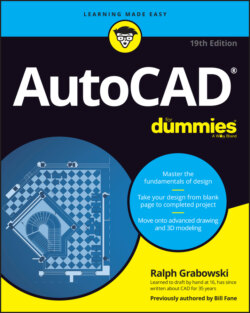Читать книгу AutoCAD For Dummies - Ralph Grabowski - Страница 13
Looking at AutoCAD’s Drawing Screen
ОглавлениеWhen you first open AutoCAD, you encounter the Start window. I can already hear your plaintive cry: “Where do I draw? The screen is full!” No problem. The Start screen (shown in Figure 2-1) is just a menu of available actions. It should be quite obvious as to what each item does. For now, just click the rectangular New button on the left side.
FIGURE 2-1: AutoCAD's Start screen.
You can always get the Start screen back by clicking its tab along the document tabs row, at the top of the large drawing area.
If the screen is partially obscured by any palettes, close them by clicking the X in their upper-left corners. AutoCAD remembers that you closed them, so the program doesn’t open them next time.
Figure 2-2 shows the screen you then see, AutoCAD’s initial drawing window.
Your screen will have a very dark gray background. I’m using a white background because it is clearer on the printed page.
Now you’re ready to get to work. Starting from the top down, AutoCAD’s interface has eight main sections:
Application menu: Click the Application button (known informally as “the red A”) at the top-left corner of the AutoCAD window to open the AutoCAD Application menu. It presents mostly file-related commands; from this menu you can create new drawings, open existing drawings, save files, or print masterpieces. It also gives access to the important Options command.FIGURE 2-2: AutoCAD’s initial drawing window.
Quick Access toolbar: This toolbar, in the top-left corner of the screen, includes buttons for some of the most commonly used functions, such as Save and Undo. You can add functions that you use all the time and delete unneeded buttons by clicking the down-facing triangle near the right-hand end of the toolbar. If you’re floundering, looking for the weird icon representing the command you want to use, click the down arrow at the right end of the Quick Access toolbar and select Show Menu Bar. The classic text-based menu appears above the Ribbon.
Ribbon: Whereas the Application menu focuses on file management, the Ribbon holds commands to create and modify drawing objects.
Document tabs: The series of tabs across the top of the graphic screen, one for each open drawing, makes it easy to jump from drawing to drawing, compared to earlier releases. New tabs appear as you open or start additional drawings. New in AutoCAD 2023, you can drag (“tear off”) file tabs to place drawings on another monitor. To return them, drag the drawing back into AutoCAD.
Graphic screen: It’s the “piece of paper” on which you draw.
Command line: This gray rectangular box at the bottom of the window is the chat room between you and AutoCAD, displaying your input to AutoCAD and (equally important) what AutoCAD says it needs from you. When you’re having a problem and all else fails, read the command line.
Layout tabs: These tabs let you switch between model space and any paper space layouts. I discuss paper space and layouts in Chapter 12.
Status bar: The status bar tells you an awful lot about how many of AutoCAD’s operating variables are set and in which way. The status bar does more than show you settings, however. You can set, reset, and change most settings from the status bar. I discuss many of these in later chapters.
Because of the way that AutoCAD was developed, you usually have four or five ways to invoke a command, primarily by using the Ribbon, keyboard entry, toolbars, the menu bar, and right-click menus. Throughout this book, I focus on the Ribbon and direct keyboard entry because the other methods, from earlier releases, aren’t necessarily turned on in recent releases of AutoCAD.
